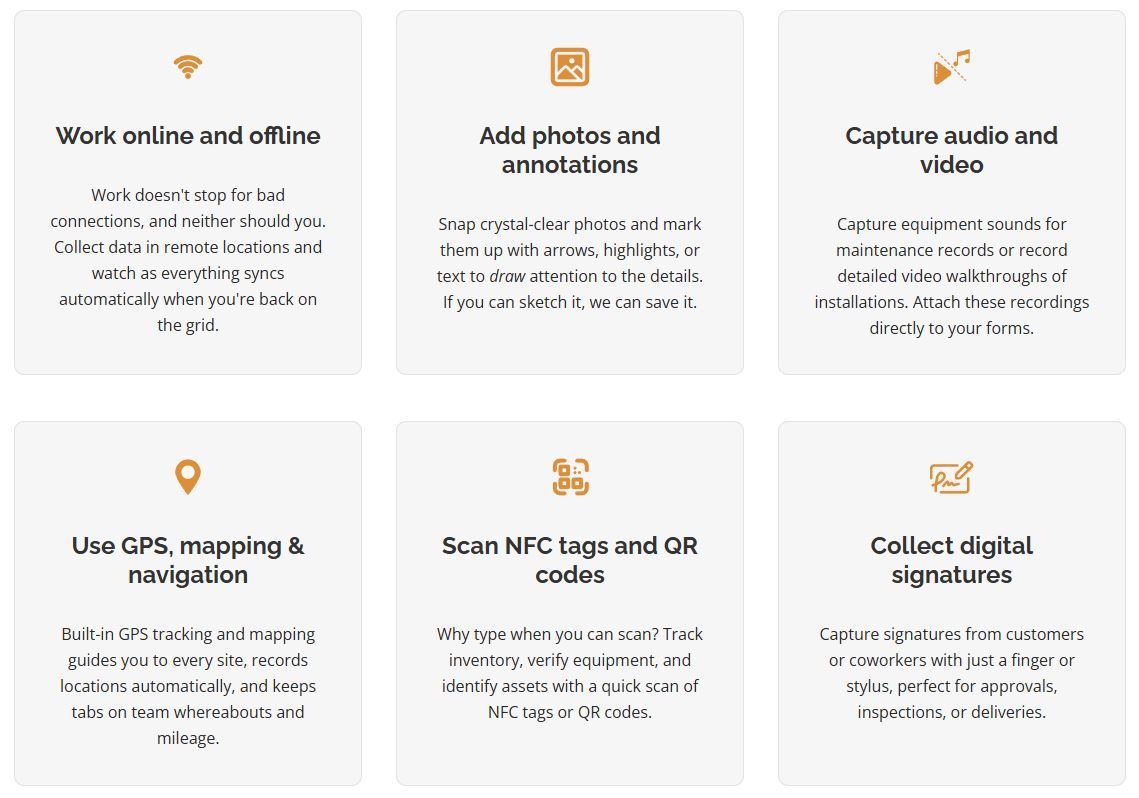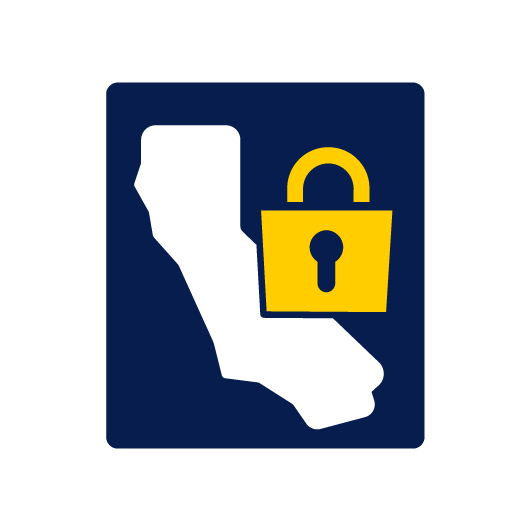Streamline Mobile Field Service Management with Forms On Fire
Your field tech is out on a job, juggling tools, paperwork, and calls. Meanwhile, you're back at the office, trying to figure out which jobs are done and who’s where. That’s the heart of mobile field service management — keeping your team connected and productive, even when they’re spread across different sites.
To keep things moving smoothly, you need a flexible and scalable mobile field service management solution like Forms On Fire.
Instead of forcing your team to adapt to rigid, one-size-fits-all software, it flips the script entirely. You get a mobile forms builder that bends to match your actual processes, captures data in real time, and keeps everyone — from field techs to back-office managers — working from the same playbook.
The cost of outdated field service processes
If you’re still relying on paper forms or clunky old software to run your field operations, you’re feeling the pain. Things fall through the cracks. Jobs take longer. Dispatch is stuck guessing where people are and what’s been done. Your back office ends up buried in data entry and follow-up calls just to keep things moving.
And your customers? They notice the delays, the miscommunication, and the lack of follow-through.
Paper-based systems are especially risky. Work orders are easy to misplace and difficult to search, and it is a nightmare to track progress. Legacy tools aren’t much better. They might’ve worked a decade ago, but today’s mobile teams need more flexibility — something that’s easy to update, simple to pull up in the field, and connected to the rest of the operation.
The role of field service mobile forms in streamlining workflows
To address the problems stated above, companies are shifting to mobile-first, customizable platforms. They want systems that support and enhance the way their team works.
Instead of adapting workflows to rigid systems, teams can build digital forms that reflect how work actually happens in the field. The benefits of doing that are substantial:
- Faster, more accurate data capture directly on mobile devices.
- Automatic validation and required fields that reduce costly mistakes.
- Real-time syncing to keep office staff updated on job progress.
- Built-in features like photos, GPS coordinates, signatures, and barcodes.
- Conditional logic that hides or shows fields to match the technician’s workflow.
- Immediate generation of reports, PDFs, or follow-up tasks.
- Reduced administrative overhead and faster billing cycles.
In short: Field service mobile forms eliminate the friction of paper, streamline data collection, and give technicians the tools they need right at the point of service.
Use Forms On Fire as your mobile field service management software
If your field team is still jumping between clipboards, spreadsheets, and outdated apps, it’s time for something better. Whether you’re in facilities management, utilities, construction, or telecommunications, Forms On Fire lets you create mobile-first solutions that match your exact processes — not someone else’s idea of how you should work.
Using our drag-and-drop interface, you build workflows around how your team already operates, with forms that collect only the data you need.
We have a bunch of premade form and app templates and features that field teams love:

Let’s check some other ways in which Forms On Fire makes life easier for any mobile workforce.
1) Custom workflows & digital forms
Forms On Fire lets you build exactly what your team needs — no coding, no cookie-cutter templates. Whether it’s inspections, service logs, job checklists, or detailed work orders, you can create forms that match your existing workflows.
And it’s not just about capturing information. You can automate the follow-up, too. For example, you can use triggers to:
- Send alerts when something needs attention.
- Automatically generate a report once a form is submitted.
- Start the next step in the process — like scheduling a follow-up or notifying the right person.
That kind of automation keeps jobs moving without anyone needing to stop and send an email or update a system manually.
It also makes data collection easier for field teams. They can log job histories, track equipment or asset details, and note how long a task takes — all while they’re on-site. You end up with clean, detailed data you can actually use. It will help you improve response times, track field service metrics, spot recurring issues, and make better decisions across the board.
2) Offline data capture
If your team works in basements, rural areas, or job sites with spotty coverage, you already know how frustrating it is to rely on apps that break the moment the signal drops. That’s why offline functionality isn’t just a bonus — it’s a must-have.
With Forms On Fire, your team has full access to their forms, workflows, and task lists even without an internet connection. They can fill out everything on their device just like they would online: snap photos, scan codes, log details, take digital signatures, and so on. Once they’re back in range, all the data they entered syncs automatically. No duplicate work, no lost info.
And here’s where it gets even better: your forms can be built to respond to how users interact with them in real time:
- Show or hide fields based on the technician's input
- Use conditional logic to guide the workflow
- Keep forms clean and relevant so no one’s overwhelmed with unnecessary fields.
This makes data entry faster and far less prone to error.
3) Integrated reporting & analytics
Real-time dashboards give operations managers a clear view of the field. You can track job statuses as they’re updated, monitor technician performance over time, and stay on top of asset conditions — all without waiting for someone to “get back to the office” with the paperwork.
But visibility is just the start. Forms On Fire also makes it easy to turn raw data into reports you can use. Whether you’re reviewing maintenance trends, checking team efficiency, or pulling numbers for leadership, you can create sharp, professional reports using tools you already know — like Word and Excel.
You decide how and when those reports are delivered:
- Instantly as PDFs
- On a schedule (daily, weekly, monthly)
- Or only when certain conditions are met.
Behind the scenes, our smart sync keeps everything up to date. Automated notifications make sure the right info gets to the right people, right on time. Instead of digging through spreadsheets or chasing updates, you’re free to focus on what the data means and what to do next.
4) Extensive mobile functionality for field teams
Your field team shouldn’t have to bounce between apps or fill out paperwork back at the office. With Forms On Fire, everything they need is in one mobile app, designed specifically for fieldwork.
Here’s what’s packed into the mobile toolkit:
- Photo, video, and audio capture: Document issues, site conditions, or equipment status directly within a form. Photos and videos act as visual proof of work, while voice recordings let techs capture details hands-free, especially when typing isn’t practical.
- Digital signatures: Get sign-off from customers, supervisors, or team leads right in the field. It’s fast, secure, and eliminates the need for printed forms or follow-up visits just to collect a signature.
- Barcoding and NFC scanning: Scan equipment, tools, or product tags instantly. This is perfect for asset tracking, inventory checks, and maintenance logs — no manual entry, no mix-ups.
- GPS and navigation: Help techs get to job sites quickly and accurately. GPS also logs the location of each job, giving you a reliable record of where and when work was completed.
This way, the field team cuts down on admin time, speeds up billing and reporting, and helps avoid disputes by keeping a clear, time-stamped record of what was done.
5) Seamless integration for a single source of truth
One of the biggest headaches in field service? Data stuck in different systems that don’t talk to each other.
A form gets filled out in the field — but someone still has to retype that info into the accounting system, then update the CRM, then flag it for billing. It’s error-prone and eats up hours of work.
Forms On Fire solves this by integrating smoothly with the tools you already use, like your ERP, CRM, or accounting software. You can:
- Automatically sync job details to your ERP for scheduling and inventory tracking.
- Push customer updates into your CRM as soon as a visit is complete.
- Trigger billing processes the moment a job is signed off.
This gives you a single, accurate source of truth across your entire operation. You get real-time insights, a faster decision-making process, and clean, consistent data without the manual overhead.
Best practices for mobile field service management
Below are three best practices to make sure your newly digitized mobile workflows actually work for the people using them.
Design with the field in mind. Don’t just copy and paste your paper forms into an app. Instead, take a step back and think about how information is captured in the field, and what happens to it afterwards.
Think about:
- What’s essential?
- What can be automated?
- What gets in the way?
Keep mobile forms short, intuitive, and easy to complete with minimal typing. Use checkboxes, dropdowns, and conditional logic to keep things simple. The goal is to reduce friction, not just move it from paper to screen.
Build buy-in early. The fastest way to kill adoption is to build something without your team’s input. Involve field staff from the start — ask what they need, what’s frustrating, and what would actually help them in the field. Then build based on that feedback.
Once you launch, don’t overcomplicate training. Focus on what your team needs to know to do their daily work. If they can pick it up quickly and see immediate value, they’ll stick with it.
Start small, then scale. You don’t have to roll out everything at once. In fact, it’s better if you don’t. Start with a high-impact workflow — maybe it’s service logs, inspections, or job completion reports. Get that right, build momentum, and expand from there. Scaling works best when it’s driven by clear wins and genuine readiness, rather than pressure to expand quickly.
Getting started with Forms On Fire
Rolling out Forms On Fire is simpler than you might think — and you’re not left to figure it out on your own. Our team is involved every step of the way, making sure that things work and that your team is set up for success.
The Sedo Laser witnessed that first-hand:

Here’s what a typical Forms On Fire implementation looks like:
- Onboarding: You’ll start with a quick kickoff where the Forms on Fire team helps you define your goals, choose where to start, and map out the first few workflows.
- Form building: You can build your own forms or apps from scratch using the drag-and-drop builder, or save time by starting with one of the ready-made templates. Either way, everything can be customized to fit your process.
- Testing and refining: Before you roll anything out, you’ll test your forms in the real world. This is your chance to make adjustments based on how your team actually uses them — add logic, tweak layouts, and simplify where needed.
- Go-live: Once things are working the way you want, you flip the switch and go live. Your team starts using the app in the field, and you get real-time data from day one.
On top of that, you also have access to a library of templates, help docs, and partners who can assist with more complex setups or integrations.
The bottom line: choose a mobile field service management software that can adapt to your needs.
Schedule a quick demo with our team and see how easy change can be.




